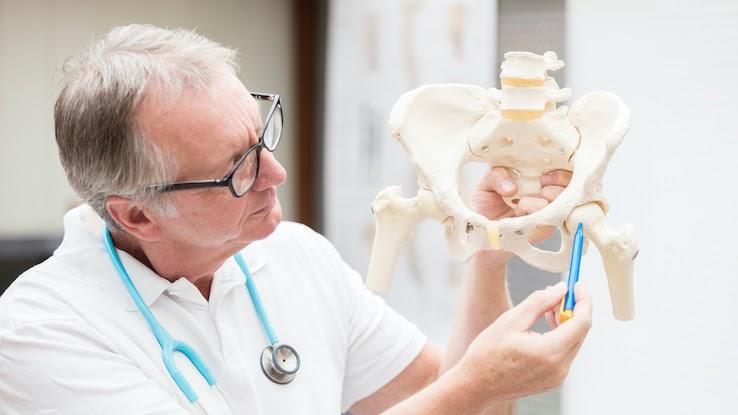
A total hip replacement, also called total hip arthroplasty, is a procedure in which a surgeon removes your hip joint and replaces it with a prosthetic joint. Typically, the doctor makes one long incision in your hip to remove the bone and cartilage that have been damaged. There’s also a less invasive version of this surgery in which the surgeon makes one or two smaller incisions to install the joint implant. This can result in a quicker recovery time.
In the United States, surgeons perform more than 450,000 hip replacements each year. There are a few different reasons why your healthcare provider may recommend you for a hip replacement surgery. Arthritis of various kinds can damage joints not just in your hip, but also in your knees and hands. Fractures or breaks can damage the joint and may cause swelling and pain. Arthrosis in your hips can also cause joints to rub together, which can be painful long term. Learn more about these and other conditions that often result in the need for hip replacement surgery.
Osteoarthritis
The most common reason for hip replacement surgery is osteoarthritis, which is the most common type of arthritis. This condition is the result of cartilage breaking down around the areas where the ends of your bones meet in your joints. When the cartilage starts to disintegrate, the bones of your joint start to rub together, causing pain and swelling.
If you have osteoarthritis in your hip, over time, your hip bones may start growing to replace the lost cartilage. These growths are known as bone spurs, or osteophytes, and they also cause stiffness and pain. Hip replacement surgery is an option that relieves pain and stiffness associated with osteoarthritis.
Some symptoms of osteoarthritis include:
- Pain
- Swelling
- Loss of flexibility
- Formation of spurs
- Inability to move the joint
- Popping or cracking noises when moving your hip
Damaged Hip Joint
Injuries, fractures and bone tumors can cause damage to your hip joint. Surgery is the most effective method of repairing this type of damage to a hip joint. There are non-invasive treatments that help relieve pain associated with damaged hip joints. However, healthcare professionals generally recommend hip replacement surgery when the pain and stiffness begin interfering with your ability to perform daily activities.
It’s rare to experience an injury after having your initial hip replacement, but if you get a fracture because of an accident or weakened bones, you may need to have the prosthetic replaced. Surgery is usually necessary if a fracture occurs in the bones around the joint following joint replacement surgery.
Rheumatoid Arthritis and Osteonecrosis
Rheumatoid arthritis is a medical condition that develops when your immune system begins attacking the membrane that lines your joint. Rheumatoid arthritis leads to inflammation, stiffness and pain. In some cases, this medical condition can destroy a hip joint entirely. Joint pain and stiffness are symptoms that directly affect the hip. If your hip pain only happens in the morning, it’s a sign of osteoarthritis.
Osteonecrosis, also called avascular necrosis, is a medical condition that can lead to the destruction of the bone in your hip joint. This condition occurs when the blood supply to the bone is restricted, usually due to an injury. This causes the bone to die. You might not feel any pain initially, but your joint will gradually become more painful over time. You may start to feel pain in the joint even when you aren’t moving. Osteoarthritis can also occur due to this condition.
Both of these conditions are severe and require hip replacement surgery.
What Are the Risks of Hip Replacement Surgery?

Serious complications happen in fewer than 2% of hip replacements. But, there are still some risks to consider. Infection and blood clots are the most common risks with a hip replacement, but your doctor will discuss prevention methods with you before surgery. There’s also the possibility of leg length inequality, meaning that one of your legs may be shorter or longer than the other after surgery. Nerve and blood vessel damage around your hip area is also possible.
The purpose of hip replacement surgery is to remove diseased or damaged areas of your hip joint. This procedure replaces parts of your hip joint with artificial parts. Hip replacement surgery can enhance your ability to move, relieve pain and improve walking. The surgery can also help reduce the effects of osteoarthritis and damage as a result of injuries or fractures.
Resource Links
“Total Hip Replacement,” OrthoInfo
“Minimally Invasive Total Hip Replacement,” OrthoInfo
“Osteoarthritis,” National Institute of Arthritis and Musculoskeletal and Skin Diseases
“Symptoms of Rheumatoid Arthritis,” NHS
“Fracture After Total Hip Replacement,” OrthoInfo
“Osteonecrosis,” National Institute of Arthritis and Musculoskeletal and Skin Diseases





